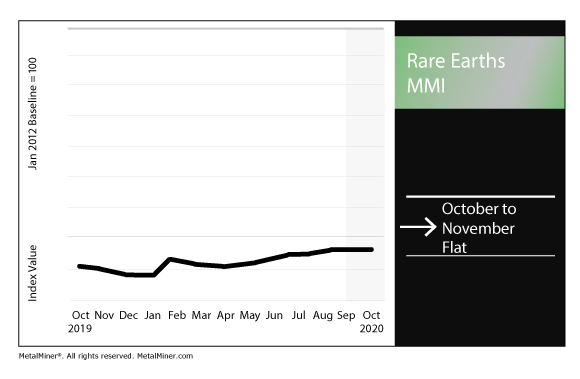Rare Earths MMI: China legislature passes export control law
The Rare Earths Monthly Metals Index (MMI) held flat once again this month.
The MetalMiner 2021 Annual Outlook consolidates our 12-month view and provides buying organizations with a complete understanding of the fundamental factors driving prices and a detailed forecast that can be used when sourcing metals for 2021 — including expected average prices, support and resistance levels.
China export control law to take effect Dec. 1
China’s legislature last month approved a new export control law that will go into effect Dec. 1, the state-run Xinhua news agency reported last month.
“China may take countermeasures against any country or region that abuses export-control measures and poses a threat to China’s national security and interests, according to the law,” Xinhua reported.
“The law also clarifies that technical documentation related to the items covered by the law is also subject to export-control stipulations.”
The law could impact exports of rare earths, for which China overwhelmingly dominates the global market.
As we have noted in this column before, the U.S. — especially the Pentagon — has long sought to diversify its rare earths supply chain. The U.S. earlier this year approved Phase 1 contracts with MP Materials and Lynas Corporation for work to develop rare earths separation facilities in the U.S.
South Korean-Australian joint project produces praseodymium, neodymium
Continuing the theme of various countries’ efforts to wean themselves off of rare earths dependence on China, Forbes recently reported on a joint venture between South Korea and Australia that has showed some promise.
The joint mineral processing project, Forbes notes, has so far produced neodymium and praseodymium. The two elements are used in permanent magnets in electric vehicles and, for praseodymium, renewable energy apparatus, like wind turbines.
Earlier this month, Australian Strategic Materials announced its acquisition of 95% the joint project, Ziron Tech. With the acquisition, ASM gained Ziron Tech’s “patented low emission, high purity metal-refining technology” and its pilot plant in Korea.
“Having the Ziron Tech team continue the innovative work on a range of high-purity and value-added critical metals used in advanced technologies, including electric vehicles and clean energy, gives ASM a strong foundation for success,” ASM Managing Director David Woodall said.
Financial Times: Chinese executives state planning rules for rare earths
In addition to the aforementioned China export control law, Chinese executives in the rare earths sector argue state-mandated limits on production are hurting both producers and end users, the Financial Times reported.
One executive cited by the Financial Times under condition of anonymity said production quotas are hurting their company financially. In addition, the unnamed executive said the quotas lead to “unstable supply” that puts stress on end users.
Lynas releases quarterly production report
Australia’s Lynas Corporation, the world’s largest rare earths producer outside of China, last month released its production totals for the quarter ended Sept. 30, 2020.
NdPr production totaled 1,342 metric tons, up from 775 metric tons the previous quarter.
Total rare earth oxide production reached 4,110 metric tons, compared with 2,579 metric tons the previous quarter.
Actual metals prices and trends
The Chinese yttrium price rose 1.6% to $33.62 per kilogram as of Nov. 1. The terbium oxide price rose 2.7% to $729.15 per kilogram.
Neodymium oxide rose 3.6% to $53,491.12 per metric ton.
Europium oxide rose 1.6% to $30.63 per kilogram. Dysprosium oxide gained 1.6% to $251.02 per kilogram.
Want MetalMiner directly in your inbox? Sign up for weekly updates now.



Leave a Reply